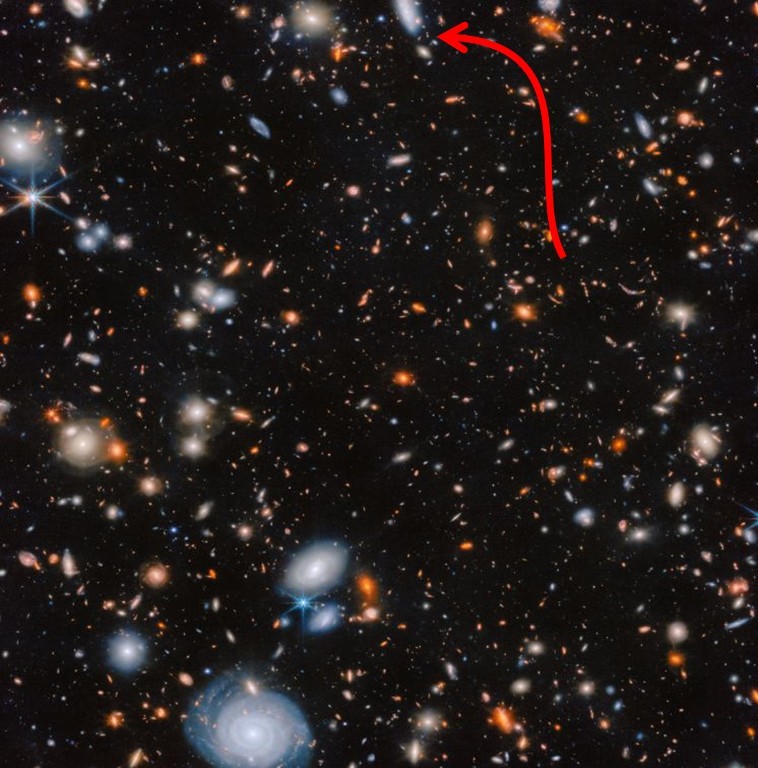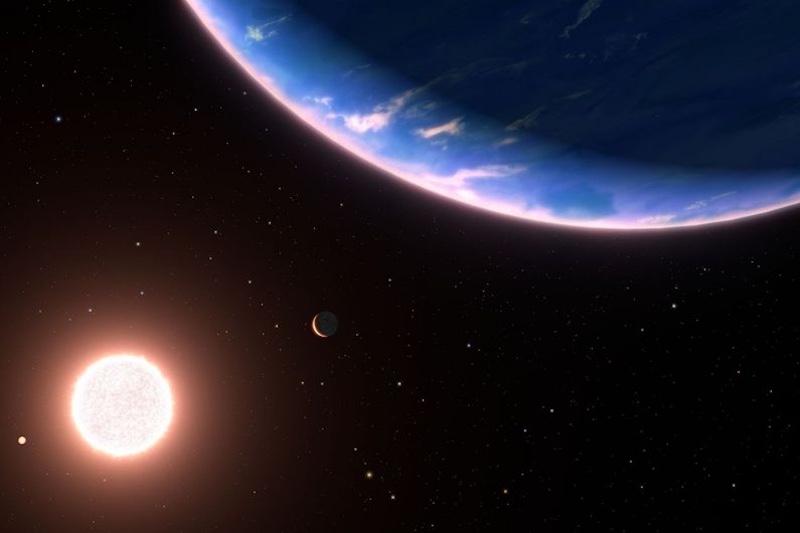Now Reading: A fast-growing supermassive black hole in the early universe
-
01
A fast-growing supermassive black hole in the early universe
A fast-growing supermassive black hole in the early universe


Science matters. Wonder matters. You matter.
Join our 2025 Donation Campaign today.
A fast-growing supermassive black hole in the early universe
When the James Webb Space Telescope looks back in time to the earliest years of our universe, it sees Little Red Dots. Astronomers think these Little Red Dots are galaxies with growing supermassive black holes. On November 19, 2025, the European Space Agency said Webb has now spotted a Little Red Dot just 570 million years after the Big Bang with a growing supermassive black hole. The black hole is so large that it challenges current theories of galaxy formation.
Astronomers have named the galaxy CANUCS-LRD-z8.6. The z8.6 refers to the object’s redshift, or how much light its light has shifted to the red end of the spectrum, which tells us how far away it is. So we see this galaxy as it was 570 million years after the Big Bang, or how it was more than 13 billion years ago. Other spectral features of this galaxy indicate that it contains a supermassive black hole feeding at a rapid rate. More rapid than even current theory could account for.
Lead author Roberta Tripodi of the University of Ljubljana in Slovenia and National Institute for Astrophysics in Rome said:
This discovery is truly remarkable. We’ve observed a galaxy from less than 600 million years after the Big Bang, and not only is it hosting a supermassive black hole, but the black hole is growing rapidly, far faster than we would expect in such a galaxy at this early time. This challenges our understanding of black hole and galaxy formation in the early universe and opens up new avenues of research into how these objects came to be.
The researchers published their peer-reviewed study in Nature Communications on November 19, 2025.
Spectra provide insights
When looking at the galaxy’s spectrum, the team saw gas that was highly ionized. Ionized gas is when atoms have been stripped of their electrons, usually by high temperatures. And in this case, the ionized gas suggested it was rotating quickly around a central black hole. The spectra could also tell them the black hole’s mass, and it was more than the researchers expected compared to the size of its galaxy.
In addition, they could see from the spectra that the galaxy had not yet produced many heavy elements. This confirmed that it was still young. Most of its stars had not yet had time to evolve and explode in supernovas, spreading the heavier elements.
Not only could they measure the mass of the black hole, but they could measure the mass of the galaxy’s stars. Co-author Nicholas Martis of the University of Ljubljana said:
The spectral features revealed by Webb provided clear signs of an accreting black hole at the center of the galaxy, something that could not have been observed with previous technology. What makes this even more compelling is that the galaxy’s black hole is overmassive compared to its stellar mass. This suggests that black holes in the early universe may have grown much faster than the galaxies that host them.
Rethinking old theories
With such a large black hole in such a young galaxy, astronomers are rethinking how galaxies and black holes grew in the early days of the universe. The galaxy CANUCS-LRD-z8.6 and its supermassive black hole suggest that black holes may have grown more quickly in the early universe. Co-author Maruša Bradac of the University of Ljubljana said:
This discovery is an exciting step in understanding the formation of the first supermassive black holes in the universe. The unexpected rapid growth of the black hole in this galaxy raises questions about the processes that allowed such massive objects to emerge so early. As we continue to analyze the data, we hope to find more galaxies like CANUCS-LRD-z8.6, which could provide us with even greater insights into the origins of black holes and galaxies.
Next, the team will make more observations, this time with both Webb and the Atacama Large Millimetre/submillimetre Array (ALMA). They hope to better understand how black holes and galaxies co-evolved in the first billion years of cosmic history.

Bottom line: Astronomers have spotted a galaxy in the early universe that has a supermassive black hole at its core that is much bigger than they expected.
Source: Extreme properties of a compact and massive accreting black hole host in the first 500 Myr
The post A fast-growing supermassive black hole in the early universe first appeared on EarthSky.
Stay Informed With the Latest & Most Important News
Previous Post
Next Post
-
 012024 in Review: Highlights from NASA in Silicon Valley
012024 in Review: Highlights from NASA in Silicon Valley -
 02Panasonic Leica Summilux DG 15mm f/1.7 ASPH review
02Panasonic Leica Summilux DG 15mm f/1.7 ASPH review -
 03How New NASA, India Earth Satellite NISAR Will See Earth
03How New NASA, India Earth Satellite NISAR Will See Earth -
 04And Thus Begins A New Year For Life On Earth
04And Thus Begins A New Year For Life On Earth -
 05Astronomy Activation Ambassadors: A New Era
05Astronomy Activation Ambassadors: A New Era -
06SpaceX launch surge helps set new global launch record in 2024
-
 07Space Force plans new ‘Futures Command’ amid pressure to speed up modernization
07Space Force plans new ‘Futures Command’ amid pressure to speed up modernization




















